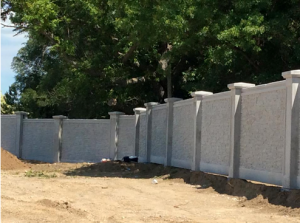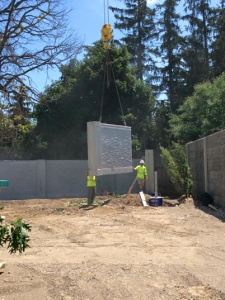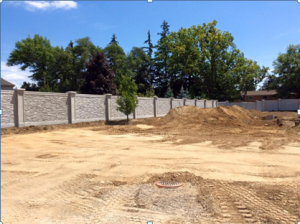Our latest Brantford project is Proof
For many developers, noise walls and concrete sound barriers are a necessary part of their land development strategy as per Ministry of Environment noise level guidelines.
Aside from cost, one of the major challenges has been aesthetics – reducing noise to acceptable decibels has rarely taken beauty into consideration.
As such, lovely subdivisions with gorgeous homes and beautiful commercial and industrial properties have been built, surrounded by ugly, towering walls.
However, new innovation in acoustic design has given developers exactly what they’ve been looking for – the ability to reduce an owners noise pollution with a wall that is also an attractive addition to the property’s overall value.

Noise walls
Sound engineers contend that noise transfers through any void the same as water can; for sound walls to be effective, all voids, joints and cracks need to be sealed to effectively minimize the noise transfer.
Because sound levels are measured using a logarithmic scale, a reduction of nine decibels is equivalent to the elimination of approximately 80 percent of the unwanted sound.
Noise barrier walls made of absorptive material mitigate sound differently than those that are a hard surface.
- Absorptive: A sound reducing barrier wall with a porous surface material and sound-dampening content material is said to be absorptive. This means little or no noise is reflected back towards the source or elsewhere.
- Reflective: Hard surfaces such as masonry or concrete are considered to be reflective. This means most of the noise is reflected back towards the noise source and beyond.
( Wikipedia resources – 1. Sound Fighter Systems, L.L.C. report: Sound Walls: Absorptive versus Reflective Design and Effectivenesshttp://www.soundfighter.com/absorptive-vs-reflective/ ) 2. Reflective and Non-reflective Highway Barriers K. Polcak (MD, SHA) and R.J. Peppin (Scantek, Inc.) case study: Reflective and Non-Reflective Highway Barriers MD SHA) TRB ADC 40 Summer Meeting, Denver, CO)
Taking the above into consideration, standard noise walls have traditionally been manufactured from a variety of materials:
- Wood
- Vinyl
- Plastic & Composites
- Concrete
However Concrete, due to its density, has proven to be one of the most effective and efficient noise barrier materials available.

Fencor Noise Barrier Fence: Beautiful AND Functional
Fencor’s Precast Concrete Accoustic Walls are capable of reducing traffic noise levels up to 10 decibels; made to various heights, they ensure the property receives the highest level of noise cancellation and abatement obtainable.
The height panel/column is created into a monolithic unit.
That, combined with the sealed interlocking nature of Fencor’s Combo-Cast™ wall panels, creates a noise wall barrier where the noises cannot penetrate through cracks, joints and crevices, which is a big step ahead of all the other reflective type of sound walls in the marketplace.
Great, right? Even better when you find out that in addition to the effectiveness of the design is our ability to customize a pattern for you that will complement the development being surrounded.
Functionality , cost efficiency AND beauty – who says you can’t have it all??
Contact us to learn more about how you can get the right noise walls for your project.






